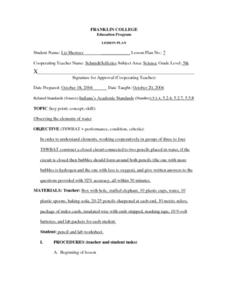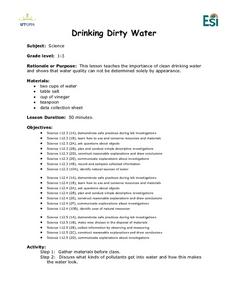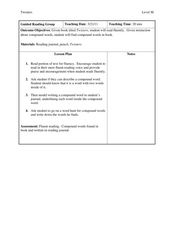Curated OER
Observing the Elements of Water
Fifth graders conduct a closed circuit experiment to observe the elements of water. They discuss the elements of Hydrogen and Oxygen, and in small groups construct a closed circuit connected to two pencils placed in water. Students...
Curated OER
Up, Up, and Away
Learners create a model to explore the water cycle. Students also perform different experiments to witness water changing from a liquid to a gas. Learners are asked to if they can find ways for water to go away without pouring the...
Curated OER
Record the Data and Find the Averages
Learners record the daily outdoor temperature as well as the number of minutes of sunlight per day over a determined period. They calculate the average temperature and minutes of sunlight per day and post their data on the project website.
Curated OER
Drinking Dirty Water
Students consider the importance of clean drinking water. They conduct a taste experiment with water, adding incremental drips of salt and vinegar to determine at which point it doesn't taste drinkable.
Curated OER
Circuit Boards
Students explore circuit boards. They determine that a complete circuit is needed to light the bulbs, experiment with the boards to develop strategies for finding where the hidden connections are, and develop strategies that can be used...
Curated OER
STABLE ANGLES OF SLOPES
Students conduct an experiment using soil and shoeboxes to explore factors controlling and affecting the slope of a hillside. They analyze angles, surfaces, etc. to gain an understanding of instability of slopes.
Curated OER
Selecting Soil Organisms in Compost
Students conduct an experiment to demonstrate that many of the enzyme systems needed to break down society's wastes exist in nature among the decomposers in a compost pile. They culture compost bacteria on starch agar to examine the...
Curated OER
Testing Foods
Students perform an experiment using brown paper bags to determine which foods have oil in them. This task assesses student's abilities to make simple observations and inferences from them.
Curated OER
Do You See What I See?
Students hypothesize the role of rocks, soil, and water by observing a terrarium and create a model to explore the water cycle. This is part of a five station set up.
Curated OER
Twisters
Learners differentiate between the terms 'tornado watch' and 'tornado warning' and simulate the conditions that produce tornadoes. They read "Night of the Twisters" by Ivy Ruckman and conduct an experiment using two-liter plastic...
Curated OER
Cancer Warrior
Students perform an experiment to determine how different salt concentrations affect the liver's ability to break down toxic hydrogen peroxide. They record and average their data which is then graphed.
Curated OER
Adding the Moon: Using a Playground Model to Explore the Movement of the Sun, Earth, and Moon
Students experience the rotation of the Earth and the Moon, and the revolution of the Moon around the Earth using a playground model.
Curated OER
Herb is the Word
Young scholars conduct an experiment to determine how different soils affect plant growth over a six-week period. After determining the physical properties of different types of soil, students plant various types of seeds into the soil...
Curated OER
Spectral Surprise
Students experience a model that produces, separating, and displaying spectral colors.
Curated OER
Measurement: When Degrees Matter
Eighth graders record the temperature change of the beakers. For this general science lesson, 8th graders create their own data table for recording observations. They discuss experimental results and cite real life applications.
Curated OER
Earth History Part II
Eighth graders hypothesize what caused the break up of continents. In this earth science lesson, 8th graders study about the events that took place during Mesozoic and Cenozoic Era. They reconstruct a supercontinent and report their...
Curated OER
Learning By Bees
High schoolers investigate learning by bees as related to vision and foraging behavior. The experiment is done outdoors where bees are foraging for food. They make their observations and record their data which is shared with the class.
Curated OER
Plotting a Magnetic Field
Students experiment with a set of materials. They plot the magnetic field that arises from a regular bar magnet. They discover how a magnet affects a compass.
Curated OER
THe Decomposition of Water
High schoolers collaborate in an experiment where they decompose water into simpler substances through the process of electrolysis. They collect, measure, and observe data and then place the data into a table. Accomodations for...
Curated OER
Plant Motion: The Untold Secrets
Students identify and categorize knowledge needed to design an experiment. They observe, recognize and describe the motion viewed. They document any changes caused by various solutions.
Curated OER
Chemistry: Plastic Milk
Young scholars observe a basic chemical reaction as vinegar is mixed with skim milk and microwaved. First, they listen to the teacher read, "Little Miss Muffet," and discover the meaning of curds and whey. While the experiment have an...
Curated OER
DNA Extraction From Living Things
Students extract DNA from split peas. In this biology lesson, students hypothesize what DNA looks like and perform the experiment to verify their hypothesis. They explain the importance of DNA in living things.
Curated OER
Conservation
Fifth graders examine how destructive fishing practices affect the health of coral reefs. They watch a Powerpoint Presentation, conduct an experiment, and in small groups create a Powerpoint Presentation.
Curated OER
Hey, Look Me Over!
Students make observations about mealworms using hand lenses, rulers, and cotton swabs. Students complete their own mealworm observation chart, then they share their observations with the class. This is one station out of five in an...























